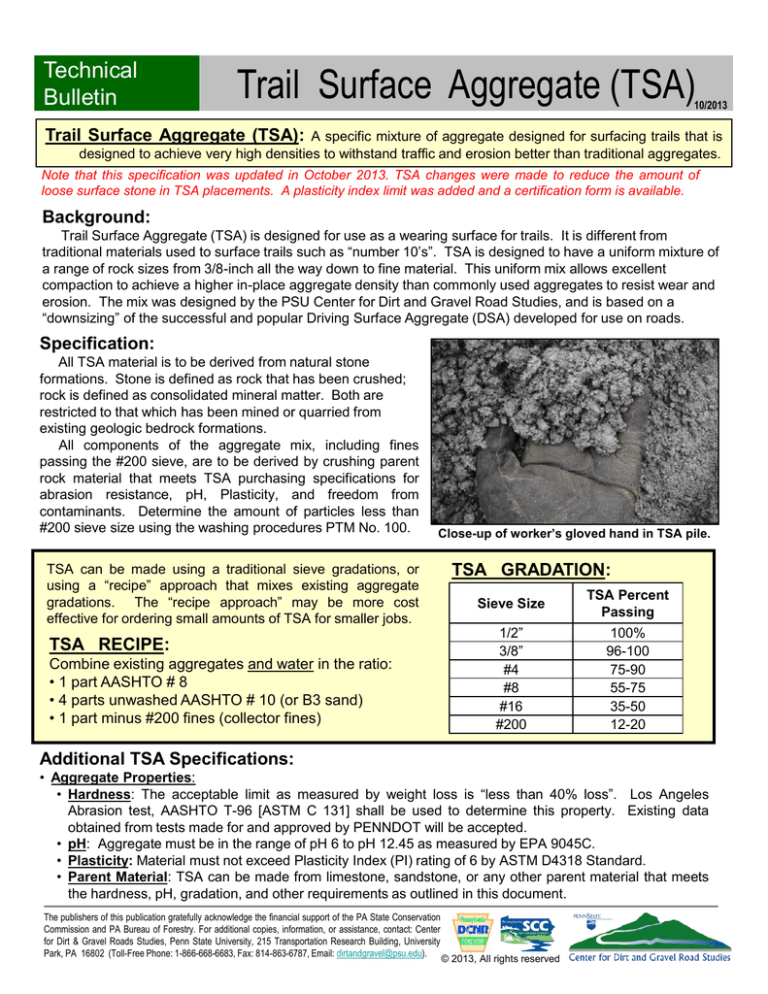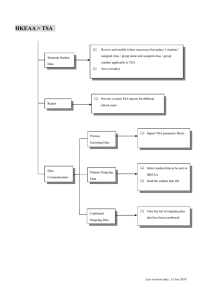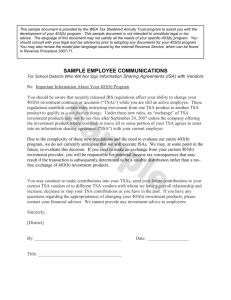
Technical
Bulletin
Trail Surface Aggregate (TSA)
10/2013
Trail Surface Aggregate (TSA):
A specific mixture of aggregate designed for surfacing trails that is
designed to achieve very high densities to withstand traffic and erosion better than traditional aggregates.
Note that this specification was updated in October 2013. TSA changes were made to reduce the amount of
loose surface stone in TSA placements. A plasticity index limit was added and a certification form is available.
Background:
Trail Surface Aggregate (TSA) is designed for use as a wearing surface for trails. It is different from
traditional materials used to surface trails such as “number 10’s”. TSA is designed to have a uniform mixture of
a range of rock sizes from 3/8-inch all the way down to fine material. This uniform mix allows excellent
compaction to achieve a higher in-place aggregate density than commonly used aggregates to resist wear and
erosion. The mix was designed by the PSU Center for Dirt and Gravel Road Studies, and is based on a
“downsizing” of the successful and popular Driving Surface Aggregate (DSA) developed for use on roads.
Specification:
All TSA material is to be derived from natural stone
formations. Stone is defined as rock that has been crushed;
rock is defined as consolidated mineral matter. Both are
restricted to that which has been mined or quarried from
existing geologic bedrock formations.
All components of the aggregate mix, including fines
passing the #200 sieve, are to be derived by crushing parent
rock material that meets TSA purchasing specifications for
abrasion resistance, pH, Plasticity, and freedom from
contaminants. Determine the amount of particles less than
#200 sieve size using the washing procedures PTM No. 100.
Close-up of worker’s gloved hand in TSA pile.
TSA can be made using a traditional sieve gradations, or
using a “recipe” approach that mixes existing aggregate
gradations. The “recipe approach” may be more cost
effective for ordering small amounts of TSA for smaller jobs.
TSA RECIPE:
Combine existing aggregates and water in the ratio:
• 1 part AASHTO # 8
• 4 parts unwashed AASHTO # 10 (or B3 sand)
• 1 part minus #200 fines (collector fines)
TSA GRADATION:
Sieve Size
TSA Percent
Passing
1/2”
3/8”
#4
#8
#16
#200
100%
96-100
75-90
55-75
35-50
12-20
Additional TSA Specifications:
• Aggregate Properties:
• Hardness: The acceptable limit as measured by weight loss is “less than 40% loss”. Los Angeles
Abrasion test, AASHTO T-96 [ASTM C 131] shall be used to determine this property. Existing data
obtained from tests made for and approved by PENNDOT will be accepted.
• pH: Aggregate must be in the range of pH 6 to pH 12.45 as measured by EPA 9045C.
• Plasticity: Material must not exceed Plasticity Index (PI) rating of 6 by ASTM D4318 Standard.
• Parent Material: TSA can be made from limestone, sandstone, or any other parent material that meets
the hardness, pH, gradation, and other requirements as outlined in this document.
The publishers of this publication gratefully acknowledge the financial support of the PA State Conservation
Commission and PA Bureau of Forestry. For additional copies, information, or assistance, contact: Center
for Dirt & Gravel Roads Studies, Penn State University, 215 Transportation Research Building, University
Park, PA 16802 (Toll-Free Phone: 1-866-668-6683, Fax: 814-863-6787, Email: dirtandgravel@psu.edu).
© 2013, All rights reserved
Additional TSA Specifications (continued)
• Optimum Moisture: Material is to be delivered and
placed at optimum moisture content as determined for
that particular source.
The optimum percentage
moisture is to be identified by the supplier in the
bid/purchasing documents. The optimum percentage
moisture is to be determined using Proctor Test ASTM
D698, procedure C, Standard.
• Transport: Truck tarps must be used to cover 100%
of the load’s exposed surface from the time of loading
until immediately before dumping, including standing
time waiting to dump.
• Placement: TSA should be placed from the furthest
point working back towards the source to avoid running
equipment on the final trail.
• Paver: When possible on large jobs, a small paver
should be used to place TSA. This will reduce
aggregate segregation by size that occurs when any
aggregate is dumped and spread.
It is
recommended that the minimum depth of placement
should be 4 inches loose, 3 inches compacted.
• “Dump and Spread”: On small trails, a paver may
be cost-prohibitive. TSA can be placed using a
“dump and spread” method on small trails. Be sure
the aggregate is not “overworked” which may cause
size segregation. TSA must be placed in one layer.
• Compaction: A minimum 3 ton vibratory roller is to
be used to compact the final surface. The initial pass
of the roller should be in static mode. TSA must be
compacted while it is at optimum moisture to achieve
maximum density. If TSA sticks to the drum of the
roller, stop and wait for the surface to dry further.
Paver-placement of TSA is preferred for longer
sections of trail as pictured above.
TSA can be successfully placed with small
equipment for short sections of trail. Proper
compaction at optimum moisture is crucial.
Note the crown in the finished surface.
Other Important TSA Considerations:
• Mixing fines: When mixing aggregates to create TSA, take care not to pre-wet any “minus #200” fines
before they are added to the mixture. Doing so may cause the fines to clump into balls that can be
difficult to break apart by mixing. These “balls” of fines will appear in the final trail, and may cause the rest
of the trail to have insufficient fine material.
• Weather: Since TSA is to be placed at optimum moisture, TSA placement is not recommended if the
forecasted weather is too cold or wet to allow the material to dry for 1-2 days after placement.
• Trail Closure: Trail use should be prohibited or restricted for TSA placement and the following day.
• Site Preparation:
• Drainage: All trail drainage concerns must be addressed before TSA placement.
• Crown: If possible, TSA (like all trail surfaces) should be placed with a crown or cross-slope of not less
than ¼” per foot 3-4% for drainage. This same crown or cross-slope should be established in the trail
base materials before TSA placement. Establish side-slope with your base, and reflect it in TSA.
• Base material: On some existing compacted trails, no base modification is required. The ideal base
course for TSA is a 2-6 inch thick layer of well graded compacted aggregate such as PennDOT’s 2A.
TSA placement directly over “open graded” stone (such as railroad ballast) is not recommended. When
placing TSA directly on fabric, a minimum 6” uncompacted aggregate depth is recommended.
• ADA accessibility: Properly placed and compacted TSA will meet all Americans with Disabilities Act
requirements for gravel surface on properly designed trails.
This publication is available in alternative media upon request. The Pennsylvania State University is committed to the policy that all persons shall have equal access to programs,
facilities, admission, and employment without regard to personal characteristics not related to ability, performance, or qualification as determined by University policy or by state or
federal authorities. The Pennsylvania State University does not discriminate against any person because of age, ancestry, color, disability or handicap, national origin, race,
religious creed, sex, sexual orientation, or veteran status. Direct all affirmative action inquiries to the Affirmative Action Office, The Pennsylvania State University, 201 Willard
Building, University Park, PA 16802-2801; tel. (814) 863-0471; TDD (814) 865-3175. U.Ed #RES-01-50.




